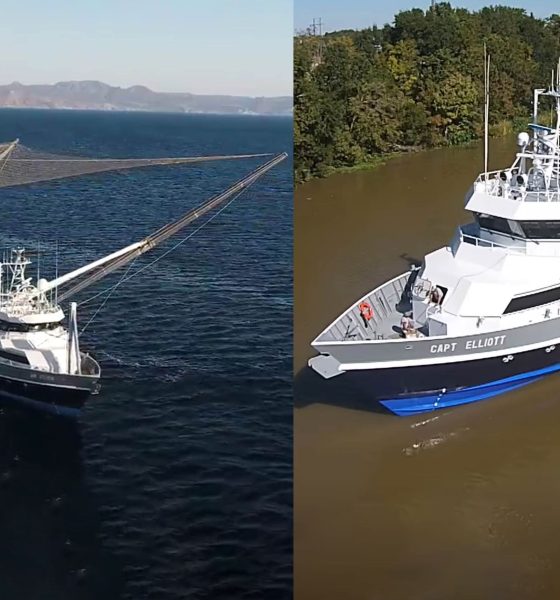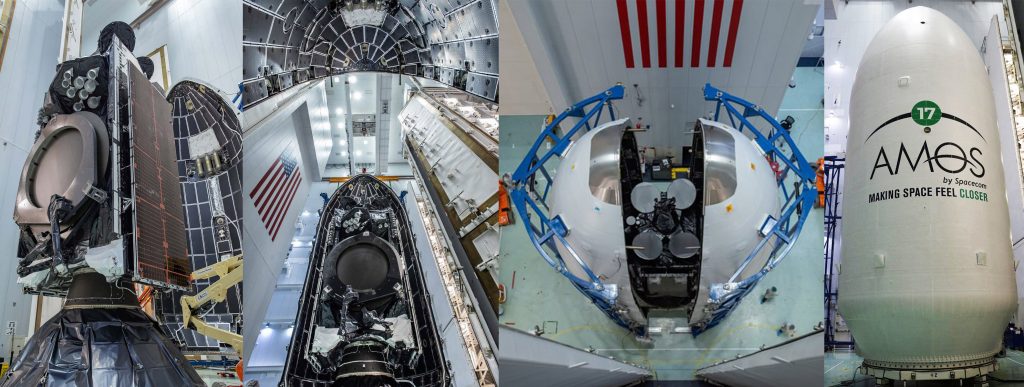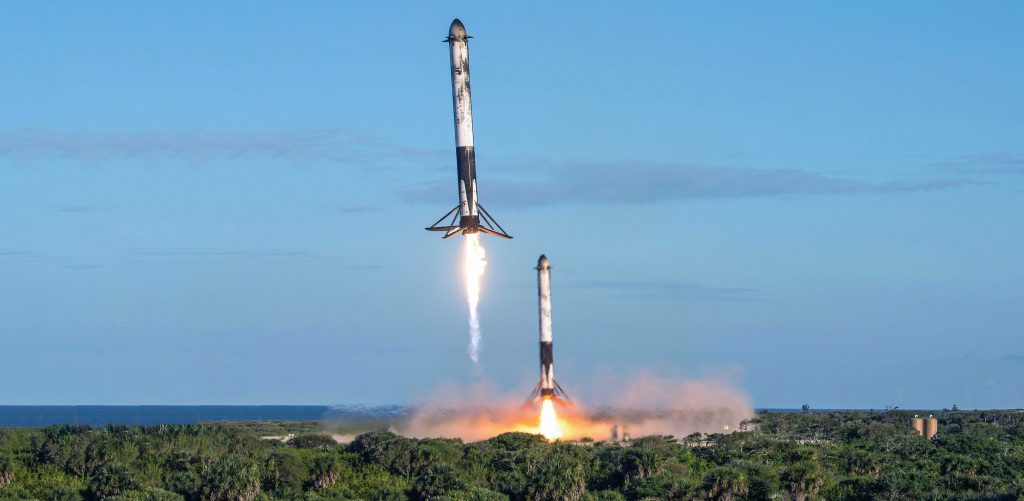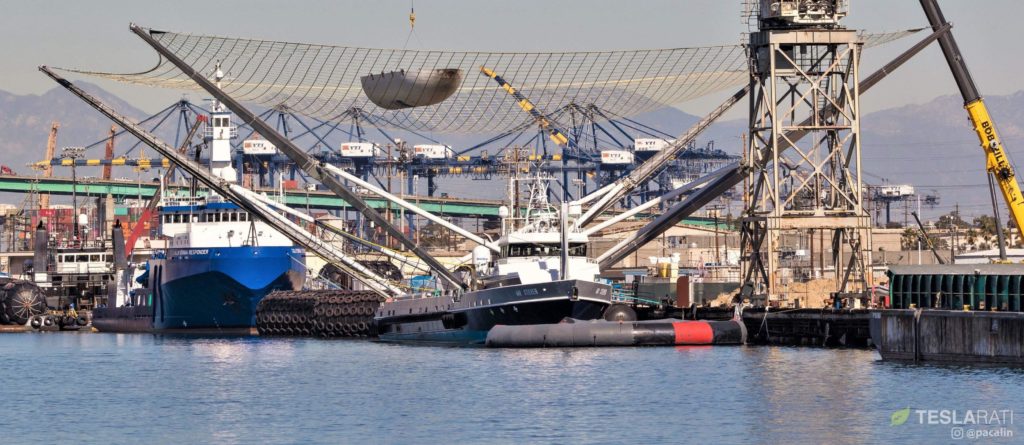

News
SpaceX adds new ship to fleet after fairing catcher Ms. Tree nails second recovery in a row
In a telltale sign that SpaceX is growing much more confident in its ability to consistently recover Falcon 9 fairings, the company has accepted delivery of second recovery ship almost identical to GO Ms. Tree (formerly Mr. Steven) just days after nailing its second fairing catch in a row.
Previously known as M/V Captain Elliott, the new ship appears to have been acquired (or leased) by Guice Offshore (GO) from SEACOR Marine, who purchased Elliott from struggling marine services company Seatran Marine in 2017. One way or another, SpaceX now has a pair of Port Canaveral-based fairing recovery ships in hand – named Ms. Tree and Ms. Chief – and is thus making excellent progress towards catching and reusing both halves of the same Falcon 9 (or Heavy) fairing.
Splurging on ‘ships
Put simply, whoever is paying for or has paid for the two fast supply vessels (FSVs) that are now a part of SpaceX’s rocket recovery fleet has/had a tidy sum to spend. For ships as large, new, and high-performance as Ms. Tree and Ms. Chief, both completed in the mid-2010s, SpaceX or GO would be lucky to pay less than $10M apiece and each ship could easily cost more than $20M, depending on a variety of unknowns. Previous owner Seatran Marine is/was admittedly in dire financial straits, so that could have resulted in an effective fire-sale discount.
Regardless, this is to say that SpaceX was likely willing to splurge and open its wallet wide for extremely high-quality fairing recovery vessels because of just how expensive those fairings are. According to CEO Elon Musk circa 2017, it costs SpaceX $5-6M total to produce a set of Falcon fairing halves, equivalent to roughly 10% of the cost of a Falcon 9 launch ($50M-60M).

As an example, assume that SpaceX paid a full $50M for Ms. Tree and Ms. Chief – effectively a worst-case cost scenario. Assume that recovering and reusing net-caught Falcon fairings still costs half as much as building new fairings ($3M for two halves), also likely a worst-case scenario given the relative mechanical and propulsive simplicity of fairings.
In this mediocre-at-best scenario, it would still take SpaceX less than 20 launches with both halves recovered to completely recoup the cost of both fairing recovery ships. In the event that reusing caught fairings is only 25% as expensive as building new fairings, SpaceX could recoup its fleet investments in just 10 launches. In fact, cost reduction may even be a secondary consideration next to the potential for effectively doubling fairing production with the same facilities. From that perspective, spending, say, $50M on development and another $50M on cutting-edge recovery vessels could easily be a bargain, especially compared to the $1B+ SpaceX has spent deloping Falcon 9 booster reusability.

Fairing-catcher Mk4
With GO Ms. Chief’s August 10th arrival at Port Canaveral, SpaceX’s team of Florida-based recovery engineers and technicians will now be tasked with modifying the ship for Falcon fairing catching. SpaceX completed its first fairing recovery-focused modifications back in late 2017, likely producing what was the first version of fairing recovery tech (Mk1). The net proved to be far too small and was replaced in summer 2018 with a net and arms likely 4X larger (Mk2).


Roughly half a year and several missed catches after Mr. Steven’s Mk2 net was installed, the ship transited the Panama Canal and arrived at Port Canaveral in February 2019. Barely a week or two later, Mr. Steven suffered a failure at sea – well before a planned catch attempt – that saw the ship limp back to port missing the entirety of its net and two of four arms.
After another four months in port, SpaceX installed a third net and arms system on Mr. Steven, featuring distinct differences and apparent upgrades that likely make it Mk3. Shortly after installation and a quick renaming from Mr. Steven to GO Ms. Tree, Ms. Tree’s inaugural Mk3 recovery attempt culminated in SpaceX’s first and second successful fairing catches – back-to-back – on June 24th and August 6th.
Finally, this brings us to the blank slate that is GO Ms. Chief. Compared to Ms. Tree, both vessels are nearly identical: both are built by Gulf Craft, LLC, both are 205 ft x 34 ft (62m x 10m), both have decks rated for ~405 metric tons (900,000 lb), and have top speeds of 26-32 knots (30-37 mph, 50-60 km/h; fully-loaded vs. empty). The lone point of difference is power: Ms. Chief’s engines produce 500 more horsepower and its generators produce an additional 120 kW of power, respective improvements of 5% and 16% relative to Ms. Tree (Mr. Steven).
Despite both ships being nearly identical, SpaceX is unlikely to simply copy and paste Ms. Tree’s thus far successful arms and net, likely instead doing what the company is famous for and fabricating a new and improved variant of the fairing recovery mechanism. This would presumably translate to Mk4. Conveniently, SpaceX appears to be heading into a rare period of no launches, likely stretching almost three months from August 6th (AMOS-17) to late October.
If Mr. Steven and Ms. Tree’s transformations are anything to go by, that hefty chunk of time that should be more than sufficient to fully outfit Ms. Chief with a fresh fairing recovery mechanism, assuming SpaceX has been simultaneously fabricating the hardware in anticipation of Ms. Chief’s arrival.
For now, we’ll have to wait and see if SpaceX’s next launches – both believed to be 60-satellite Starlink missions – will mark the recovery debut of Ms. Chief, as well as the first attempted catch of both Falcon fairing halves. Additionally, following SpaceX’s second successful fairing half catch on August 6th, it’s possible that the company has two recovered halves capable of making a full, flight-proven fairing. Either way, a Starlink launch will likely support the flight-debut of a reused fairing and will almost certainly host the first attempted simultaneous recovery of both fairing halves.
Check out Teslarati’s Marketplace! We offer Tesla accessories, including for the Tesla Cybertruck and Tesla Model 3.

Elon Musk
Elon Musk’s X will start using a Tesla-like software update strategy
The initiative seems designed to accelerate updates to the social media platform, while maintaining maximum transparency.

Elon Musk’s social media platform X will adopt a Tesla-esque approach to software updates for its algorithm.
The initiative seems designed to accelerate updates to the social media platform, while maintaining maximum transparency.
X’s updates to its updates
As per Musk in a post on X, the social media company will be making a new algorithm to determine what organic and advertising posts are recommended to users. These updates would then be repeated every four weeks.
“We will make the new 𝕏 algorithm, including all code used to determine what organic and advertising posts are recommended to users, open source in 7 days. This will be repeated every 4 weeks, with comprehensive developer notes, to help you understand what changed,” Musk wrote in his post.
The initiative somewhat mirrors Tesla’s over-the-air update model, where vehicle software is regularly refined and pushed to users with detailed release notes. This should allow users to better understand the details of X’s every update and foster a healthy feedback loop for the social media platform.
xAI and X
X, formerly Twitter, has been acquired by Elon Musk’s artificial intelligence startup, xAI last year. Since then, xAI has seen a rapid rise in valuation. Following the company’s the company’s upsized $20 billion Series E funding round, estimates now suggest that xAI is worth tens about $230 to $235 billion. That’s several times larger than Tesla when Elon Musk received his controversial 2018 CEO Performance Award.
As per xAI, the Series E funding round attracted a diverse group of investors, including Valor Equity Partners, Stepstone Group, Fidelity Management & Research Company, Qatar Investment Authority, MGX, and Baron Capital Group, among others. Strategic partners NVIDIA and Cisco Investments also continued support for building the world’s largest GPU clusters.
News
Tesla FSD Supervised wins MotorTrend’s Best Driver Assistance Award
The decision marks a notable reversal for the publication from prior years, with judges citing major real-world improvements that pushed Tesla’s latest FSD software ahead of every competing ADAS system.

Tesla’s Full Self-Driving (Supervised) system has been named the best driver-assistance technology on the market, earning top honors at the 2026 MotorTrend Best Tech Awards.
The decision marks a notable reversal for the publication from prior years, with judges citing major real-world improvements that pushed Tesla’s latest FSD software ahead of every competing ADAS system. And it wasn’t even close.
MotorTrend reverses course
MotorTrend awarded Tesla FSD (Supervised) its 2026 Best Tech Driver Assistance title after extensive testing of the latest v14 software. The publication acknowledged that it had previously criticized earlier versions of FSD for erratic behavior and near-miss incidents, ultimately favoring rivals such as GM’s Super Cruise in earlier evaluations.
According to MotorTrend, the newest iteration of FSD resolved many of those shortcomings. Testers said v14 showed far smoother behavior in complex urban scenarios, including unprotected left turns, traffic circles, emergency vehicles, and dense city streets. While the system still requires constant driver supervision, judges concluded that no other advanced driver-assistance system currently matches its breadth of capability.
Unlike rival systems that rely on combinations of cameras, radar, lidar, and mapped highways, Tesla’s FSD operates using a camera-only approach and is capable of driving on city streets, rural roads, and freeways. MotorTrend stated that pure utility, the ability to handle nearly all road types, ultimately separated FSD from competitors like Ford BlueCruise, GM Super Cruise, and BMW’s Highway Assistant.
High cost and high capability
MotorTrend also addressed FSD’s pricing, which remains significantly higher than rival systems. Tesla currently charges $8,000 for a one-time purchase or $99 per month for a subscription, compared with far lower upfront and subscription costs from other automakers. The publication noted that the premium is justified given FSD’s unmatched scope and continuous software evolution.
Safety remained a central focus of the evaluation. While testers reported collision-free operation over thousands of miles, they noted ongoing concerns around FSD’s configurable driving modes, including options that allow aggressive driving and speeds beyond posted limits. MotorTrend emphasized that, like all Level 2 systems, FSD still depends on a fully attentive human driver at all times.
Despite those caveats, the publication concluded that Tesla’s rapid software progress fundamentally reshaped the competitive landscape. For drivers seeking the most capable hands-on driver-assistance system available today, MotorTrend concluded Tesla FSD (Supervised) now stands alone at the top.
News
Elon Musk’s Grokipedia surges to 5.6M articles, almost 79% of English Wikipedia
The explosive growth marks a major milestone for the AI-powered online encyclopedia, which was launched by Elon Musk’s xAI just months ago.

Elon Musk’s Grokipedia has grown to an impressive 5,615,201 articles as of today, closing in on 79% of the English Wikipedia’s current total of 7,119,376 articles.
The explosive growth marks a major milestone for the AI-powered online encyclopedia, which was launched by Elon Musk’s xAI just months ago. Needless to say, it would only be a matter of time before Grokipedia exceeds English Wikipedia in sheer volume.
Grokipedia’s rapid growth
xAI’s vision for Grokipedia emphasizes neutrality, while Grok’s reasoning capabilities allow for fast drafting and fact-checking. When Elon Musk announced the initiative in late September 2025, he noted that Grokipedia would be an improvement to Wikipedia because it would be designed to avoid bias.
At the time, Musk noted that Grokipedia “is a necessary step towards the xAI goal of understanding the Universe.”
Grokipedia was launched in late October, and while xAI was careful to list it only as Version 0.1 at the time, the online encyclopedia immediately earned praise. Wikipedia co-founder Larry Sanger highlighted the project’s innovative approach, noting how it leverages AI to fill knowledge gaps and enable rapid updates. Netizens also observed how Grokipedia tends to present articles in a more objective manner compared to Wikipedia, which is edited by humans.
Elon Musk’s ambitious plans
With 5,615,201 total articles, Grokipedia has now grown to almost 79% of English Wikipedia’s article base. This is incredibly quick, though Grokipedia remains text-only for now. xAI, for its part, has now updated the online encyclopedia’s iteration to v0.2.
Elon Musk has shared bold ideas for Grokipedia, including sending a record of the entire knowledge base to space as part of xAI’s mission to preserve and expand human understanding. At some point, Musk stated that Grokipedia will be renamed to Encyclopedia Galactica, and it will be sent to the cosmos.
“When Grokipedia is good enough (long way to go), we will change the name to Encyclopedia Galactica. It will be an open source distillation of all knowledge, including audio, images and video. Join xAI to help build the sci-fi version of the Library of Alexandria!” Musk wrote, adding in a later post that “Copies will be etched in stone and sent to the Moon, Mars and beyond. This time, it will not be lost.”








